Intel's Pentium 4 670: Just Another Speed Bump
by Derek Wilson on May 26, 2005 9:00 AM EST- Posted in
- CPUs
The Test and Business/General Use Performance
The Test
Our hardware configurations are similar to what we've used in previous comparisons.AMD Athlon 64 Configuration
Socket-939 Athlon 64 CPUs
2 x 512MB OCZ PC3200 EL Dual Channel DIMMs 2-2-2-10
NVIDIA nForce4 Reference Motherboard
ATI Radeon X800 XT PCI Express
Intel Pentium 4 Configuration
LGA-775 Intel Pentium 4 and Extreme Edition CPUs
2 x 512MB Crucial DDR-II 533 Dual Channel DIMMs 3-3-3-12
Intel 925XE and 945G Motherboards
ATI Radeon X800 XT PCI Express
Business/General Use Performance
Business Winstone 2004Business Winstone 2004 tests the following applications in various usage scenarios:
. Microsoft Access 2002
. Microsoft Excel 2002
. Microsoft FrontPage 2002
. Microsoft Outlook 2002
. Microsoft PowerPoint 2002
. Microsoft Project 2002
. Microsoft Word 2002
. Norton AntiVirus Professional Edition 2003
. WinZip 8.1
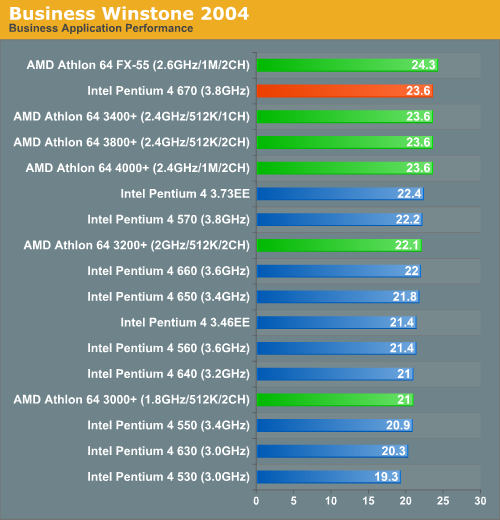
Office Productivity SYSMark 2004
SYSMark's Office Productivity suite consists of three tests, the first of which is the Communication test. The Communication test consists of the following:"The user receives an email in Outlook 2002 that contains a collection of documents in a zip file. The user reviews his email and updates his calendar while VirusScan 7.0 scans the system. The corporate web site is viewed in Internet Explorer 6.0. Finally, Internet Explorer is used to look at samples of the web pages and documents created during the scenario."
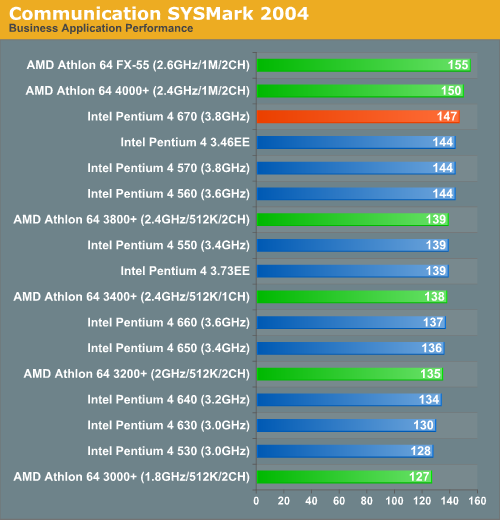
The next test is Document Creation performance, which shows very little difference in drive performance between the contenders:
"The user edits the document using Word 2002. He transcribes an audio file into a document using Dragon NaturallySpeaking 6. Once the document has all the necessary pieces in place, the user changes it into a portable format for easy and secure distribution using Acrobat 5.0.5. The user creates a marketing presentation in PowerPoint 2002 and adds elements to a slide show template."
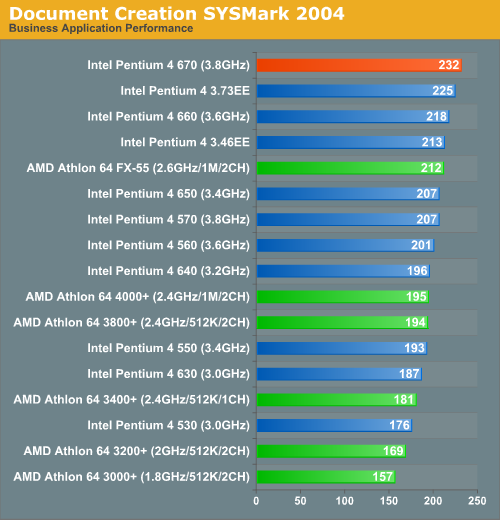
The final test in our Office Productivity suite is Data Analysis, which BAPCo describes as:
"The user opens a database using Access 2002 and runs some queries. A collection of documents are archived using WinZip 8.1. The queries' results are imported into a spreadsheet using Excel 2002 and are used to generate graphical charts."
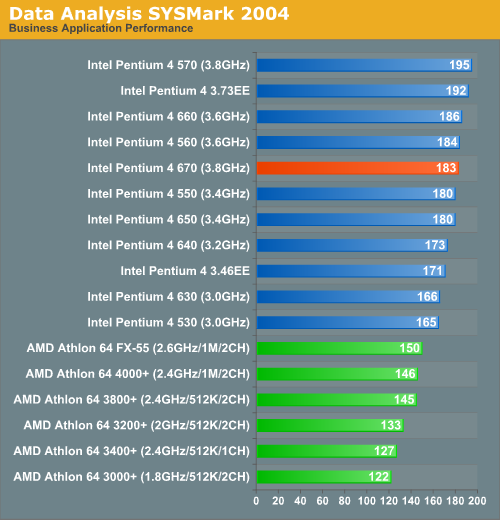
Microsoft Office XP SP-2
Here, we see in that the purest of office application tests, performance doesn't vary all too much.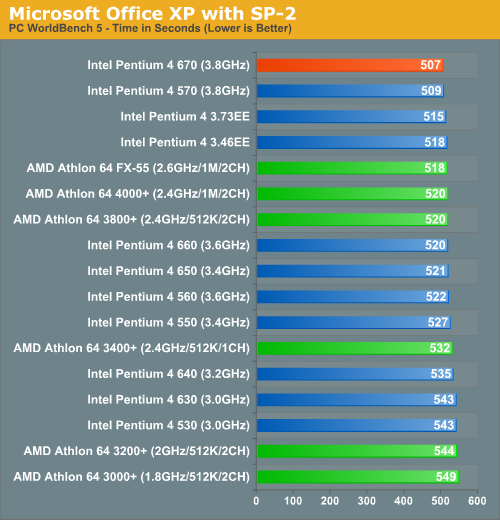
Mozilla 1.4
Quite possibly the most frequently used application on any desktop is the one that we pay the least amount of attention to when it comes to performance. While a bit older than the core that is now used in Firefox, performance in Mozilla is worth looking at as many users are switching from IE to a much more capable browser on the PC - Firefox.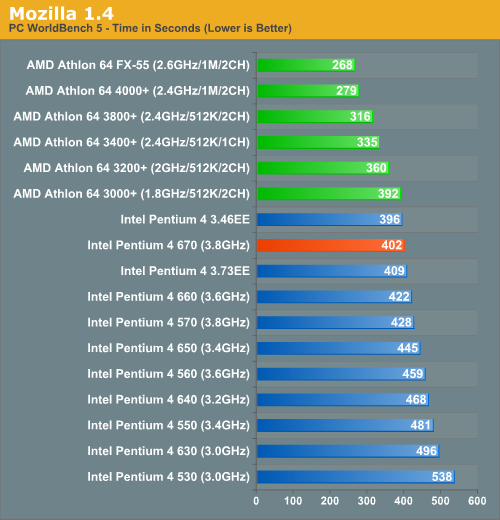
ACD Systems ACDSee PowerPack 5.0
ACDSee is a popular image editing tool that is great for basic image editing options such as batch resizing, rotating, cropping and other such features that are too elementary to justify purchasing something as powerful as Photoshop. There are no extremely complex filters here, just pure batch image processing.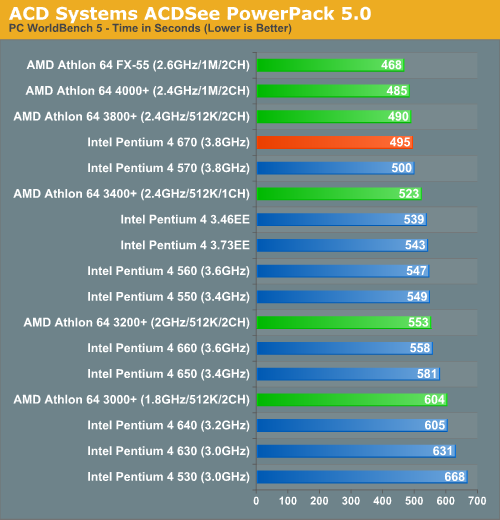
Ahead Software Nero Express 6.0.0.3
While it was a major issue in the past, buffer underrun errors while burning a CD or DVD are few and far between these days, thanks to high performance CPUs as well as vastly improved optical drives. When you take the optical drive out of the equation, how do these CPU's stack up with burning performance?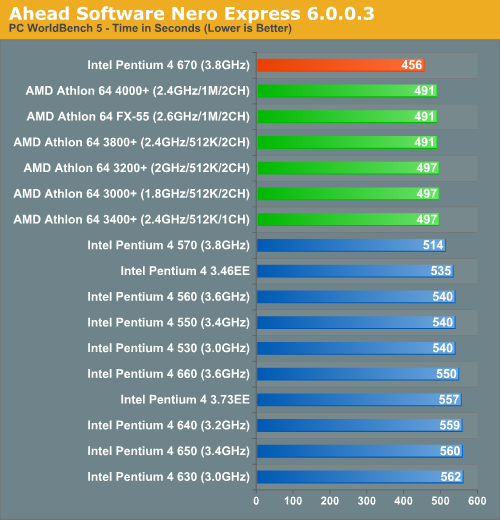
Winzip
Archiving performance ends up being fairly CPU bound as well as I/O limited.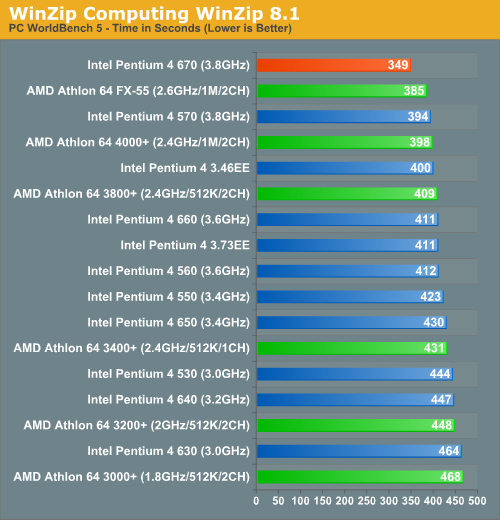










33 Comments
View All Comments
JustAnAverageGuy - Thursday, May 26, 2005 - link
"And I suppose if AMD released a venice core clocked @ 2.6 Ghz, you all would not be calling it "just a speed bump". Rather, it would be considered a huge deal, and you all WOULD care."2.4 --> 2.6 != 3.6 --> 3.8 (% speed increase)
Also consider the fact that 200 "A64 Mhz" aren't equal to 200 "P4 MHz"
AkumaX - Thursday, May 26, 2005 - link
#11,They're trying to distinguish between S754 and S939 (single channel vs dual channel memory)
is my S754 Newcastle @ 10 x 240 = 2400mhz really that slow? :P
Admiral Ackbar - Thursday, May 26, 2005 - link
Sorry but I have missed something, what does the 1CH versus 2CH mean on the Athlons?mjz - Thursday, May 26, 2005 - link
5 - Posted on May 26, 2005 at 2:42 PM by flatblastard ReplyAnd I suppose if AMD released a venice core clocked @ 2.6 Ghz, you all would not be calling it "just a speed bump". Rather, it would be considered a huge deal, and you all WOULD care.
----
don't forget, a 200 MHz increase with AMD cpus is like a 300+ MHz increase for intel
ViRGE - Thursday, May 26, 2005 - link
#3 is right, there are some major discrepancies between the actual results and what was predicted. Take a look at the WinZip and Nero numbers; for Winzip, the 650->660->670 comes in at 430->411->349 respectively(or a difference of 29->62), and Nero shows 560->550->456(for a difference of 10->94!). Something has to have been changed her, be it a hard drive or drivers; the 670 scores do no correlate with the other 6xx scores at all.mlittl3 - Thursday, May 26, 2005 - link
#5,This article would be worded totally different if the 670 performed consistently better than the 570 from benchmark to benchmark. Instead it wins some and loses some.
As #4 says, even the 3.43 gallatin EE beats the 3.73 prescott EE in a lot of the benchmarks.
Intel is unreliable when it comes to new processors until the Pentium M is revamped in the form of Yonah and of course as #6 stated Conroe (don't forget Cedar Mill).
AMD was bashed left and right when they went from Palamino to Thoroughbred A to Thoroughbred B to Barton. There were very little performance improvements between these chips and they kept getting hotter and hotter. Review sites were constantly saying that the Athlon XP had gone as far as it can go and ran out of steam around the Athlon XP 2500+.
Therefore, AMD came out with the Athlon 64 and fixed all the problems. Each release of a new chip usually has brought speed improvements and decreased power usage.
Now its Intel's turn. The Pentium 4 architecture has run out of steam. Each new processor brings nothing new to the table and in some cases hurts performance. The Pentium 4 was at the peak with the Northwood core, therefore, logically, reviews sites and comment boards are bashing Intel.
Once Intel releases the next gen processors and AMD's Athlon 64 runs out of steam, the review sites and comment boards will change directions once again as always.
Please read this article at xbitlabs for further info on the history of the Pentium 4 and why Intel is no longer going to support it soon.
http://www.xbitlabs.com/articles/cpu/display/netbu...
yacoub - Thursday, May 26, 2005 - link
"In order to continue getting the same performance boost form part to part"form/from
=)
BitByBit - Thursday, May 26, 2005 - link
The 6xx line is to the Athlon 64 as Barton was to the P4C - just a fill-in to avoid embarrassing benchmark defeats until Intel's replacement appears; Conroe.flatblastard - Thursday, May 26, 2005 - link
And I suppose if AMD released a venice core clocked @ 2.6 Ghz, you all would not be calling it "just a speed bump". Rather, it would be considered a huge deal, and you all WOULD care.plewis00 - Thursday, May 26, 2005 - link
It does perform well in somethings but the increased latency is bad - the last benchmark, SPECviewperf 8 - Unigraphics V17, where the 5xx series pretty much consistently beat the 6xx, that is awful when it costs so much more, if you pay more for something you'd expect it to perform better. Similar thing with the 3.4XE (Gallatin-based) and 3.73XE (Prescott-based) in the past. Like many others I'm jumping ship on Intel now unless I can easily get a hold of a Pentium M SFF with SATA support (I'd rather not get the 915 cos of PCIe and DDR2), let's face it, Pentium M is pretty much Intel's only strong performer these days...